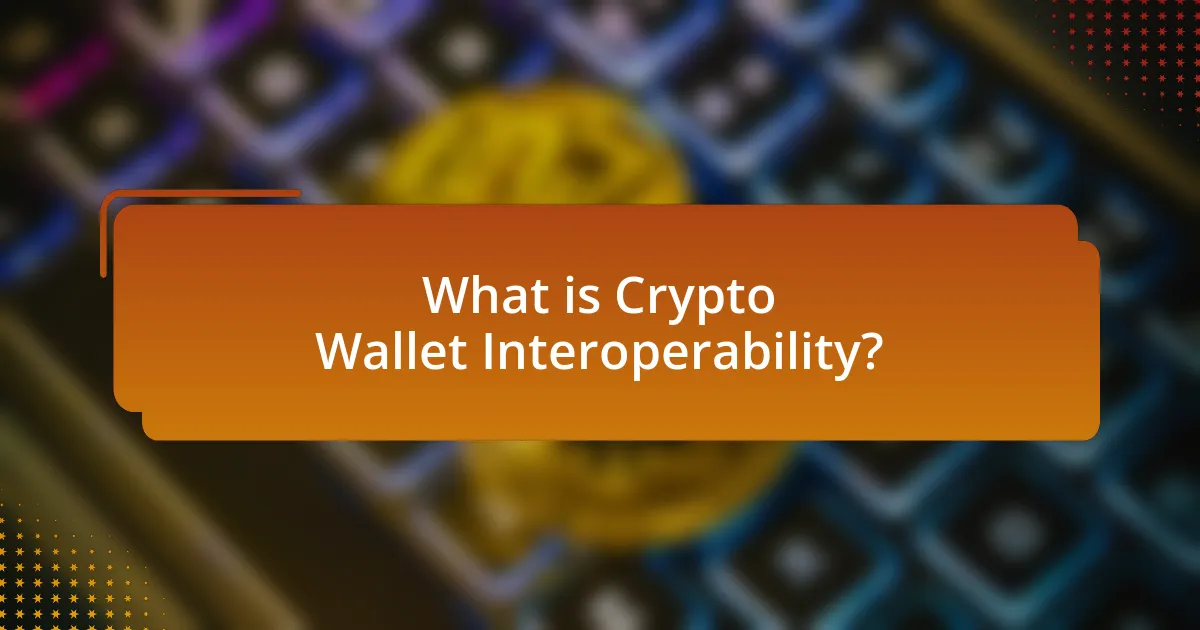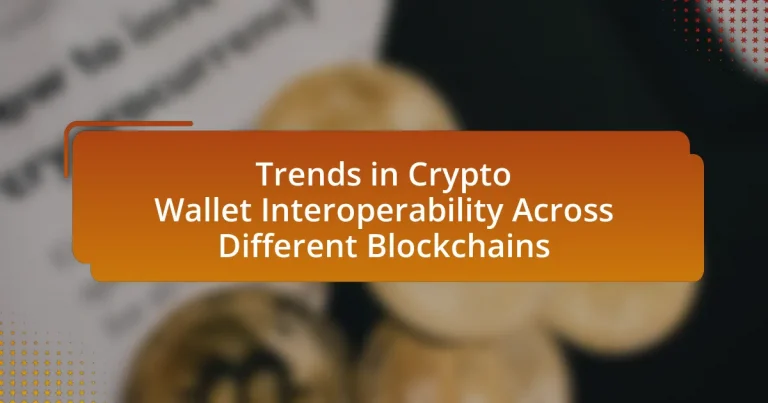Crypto wallet interoperability is the capability of different cryptocurrency wallets to communicate and function across various blockchain networks, allowing users to transfer assets and manage holdings seamlessly. This article explores the mechanisms that enable interoperability, such as cross-chain protocols and standardized communication methods, and highlights the importance of these features for enhancing user experience in the decentralized finance (DeFi) landscape. It also addresses current trends, challenges, and future prospects in wallet interoperability, emphasizing the role of emerging technologies and user demand in shaping the evolution of this critical aspect of the cryptocurrency ecosystem. Additionally, best practices for ensuring security and optimizing user experience with multi-chain wallets are discussed.

What is Crypto Wallet Interoperability?
Crypto wallet interoperability refers to the ability of different cryptocurrency wallets to communicate and work seamlessly with one another across various blockchain networks. This functionality allows users to transfer assets, access services, and manage their holdings without being restricted to a single wallet or blockchain ecosystem. For instance, interoperability can enable a user to send Bitcoin from a wallet that primarily supports Ethereum, enhancing user experience and expanding the utility of digital assets. The growing emphasis on interoperability is driven by the increasing number of blockchain platforms and the need for a cohesive user experience in the decentralized finance (DeFi) space.
How does Crypto Wallet Interoperability function across different blockchains?
Crypto wallet interoperability functions through the use of cross-chain protocols and standards that enable seamless transactions and data exchange between different blockchain networks. These protocols, such as atomic swaps and wrapped tokens, allow users to transfer assets across blockchains without the need for centralized exchanges. For instance, atomic swaps facilitate direct peer-to-peer exchanges of cryptocurrencies from different blockchains, while wrapped tokens represent assets from one blockchain on another, maintaining their value and usability. This interoperability is crucial for enhancing liquidity and user experience in the decentralized finance ecosystem, as it allows users to access a broader range of services and assets across multiple platforms.
What are the key components that enable interoperability in crypto wallets?
The key components that enable interoperability in crypto wallets include standardized protocols, cross-chain communication mechanisms, and decentralized identity solutions. Standardized protocols, such as ERC-20 and ERC-721, allow different wallets to recognize and manage various token types across multiple blockchains. Cross-chain communication mechanisms, like atomic swaps and wrapped tokens, facilitate transactions between distinct blockchain networks, ensuring seamless asset transfers. Decentralized identity solutions enhance user authentication and data sharing across platforms, promoting a unified experience. These components collectively enhance the functionality and usability of crypto wallets, enabling users to interact with diverse blockchain ecosystems efficiently.
How do different blockchain protocols influence wallet interoperability?
Different blockchain protocols significantly influence wallet interoperability by determining the standards and protocols that wallets must adhere to for cross-chain functionality. For instance, Ethereum’s ERC-20 token standard allows wallets to support a wide range of tokens, enhancing interoperability among wallets that comply with this standard. Conversely, protocols like Bitcoin, which do not support smart contracts, limit the types of interactions wallets can facilitate, thereby reducing interoperability with more versatile blockchains. Additionally, interoperability solutions such as wrapped tokens and cross-chain bridges are often tailored to specific protocols, further affecting how wallets can interact across different blockchain ecosystems.
Why is Crypto Wallet Interoperability important for users?
Crypto wallet interoperability is important for users because it enables seamless transactions across different blockchain networks. This functionality allows users to manage multiple cryptocurrencies and tokens from various platforms without the need for multiple wallets, enhancing convenience and efficiency. For instance, according to a report by Chainalysis, interoperability can significantly reduce transaction costs and time, as users can transfer assets directly between wallets on different blockchains without relying on centralized exchanges. This capability not only improves user experience but also fosters greater liquidity and accessibility in the cryptocurrency market.
What advantages does interoperability provide to crypto wallet users?
Interoperability provides crypto wallet users with enhanced flexibility and access to a broader range of assets across multiple blockchains. This capability allows users to seamlessly transfer and manage cryptocurrencies without being restricted to a single blockchain ecosystem. For instance, users can easily swap tokens between Ethereum and Binance Smart Chain, facilitating better liquidity and investment opportunities. Additionally, interoperability reduces the need for multiple wallets, streamlining the user experience and enhancing security by minimizing the number of private keys that users must manage.
How does interoperability enhance the overall user experience in the crypto space?
Interoperability enhances the overall user experience in the crypto space by allowing seamless transactions and interactions across different blockchain networks. This capability enables users to transfer assets and data without the need for multiple wallets or exchanges, significantly reducing friction in the process. For instance, platforms like Polkadot and Cosmos facilitate cross-chain communication, which allows users to engage with various decentralized applications (dApps) and services without being restricted to a single blockchain. As a result, users benefit from increased accessibility, greater liquidity, and a more cohesive ecosystem, ultimately leading to a more efficient and user-friendly experience in managing their crypto assets.

What are the current trends in Crypto Wallet Interoperability?
Current trends in crypto wallet interoperability include the development of cross-chain protocols, the integration of decentralized finance (DeFi) applications, and the rise of multi-signature wallets. Cross-chain protocols, such as Polkadot and Cosmos, enable seamless transactions between different blockchains, enhancing user experience and asset accessibility. The integration of DeFi applications allows users to manage assets across various platforms without needing multiple wallets, streamlining the process. Additionally, multi-signature wallets are gaining popularity for their enhanced security features, requiring multiple approvals for transactions, which is particularly appealing for institutional investors. These trends reflect a growing emphasis on user convenience, security, and the need for a cohesive ecosystem in the rapidly evolving crypto landscape.
How are emerging technologies shaping wallet interoperability?
Emerging technologies are significantly enhancing wallet interoperability by enabling seamless communication and transactions across different blockchain networks. Innovations such as cross-chain protocols, decentralized finance (DeFi) solutions, and interoperability-focused blockchain platforms facilitate the transfer of assets and data between diverse wallets. For instance, projects like Polkadot and Cosmos utilize unique architectures that allow multiple blockchains to interoperate, thereby improving user experience and expanding the functionality of crypto wallets. Additionally, advancements in smart contract technology enable automated processes that further streamline interactions between wallets on different chains, making transactions more efficient and secure.
What role do cross-chain protocols play in enhancing interoperability?
Cross-chain protocols facilitate interoperability by enabling seamless communication and transactions between different blockchain networks. These protocols allow assets and data to be transferred across disparate chains, thereby breaking down silos and enhancing user experience. For instance, protocols like Polkadot and Cosmos utilize unique architectures that support cross-chain interactions, allowing decentralized applications to operate across multiple blockchains. This capability is crucial as it promotes liquidity, expands market access, and fosters innovation by allowing developers to leverage the strengths of various blockchain ecosystems.
How are decentralized finance (DeFi) applications influencing wallet interoperability trends?
Decentralized finance (DeFi) applications are significantly driving wallet interoperability trends by necessitating seamless interactions across multiple blockchain networks. As DeFi platforms often require users to engage with various tokens and assets, the demand for wallets that can support diverse blockchain ecosystems has increased. This trend is evidenced by the rise of multi-chain wallets, which allow users to manage assets from different blockchains in a single interface, thereby enhancing user experience and accessibility. Furthermore, the integration of cross-chain protocols, such as Polkadot and Cosmos, facilitates interoperability by enabling assets to move freely between different blockchains, further solidifying the influence of DeFi on wallet interoperability.
What challenges are faced in achieving seamless interoperability?
Achieving seamless interoperability in crypto wallets across different blockchains faces several challenges, primarily due to the diversity of blockchain protocols and standards. Each blockchain operates on its own set of rules, consensus mechanisms, and data structures, which complicates the integration process. For instance, Ethereum uses smart contracts while Bitcoin relies on a simpler transaction model, creating inherent compatibility issues. Additionally, security concerns arise as interoperability solutions may introduce vulnerabilities, making wallets susceptible to attacks. Furthermore, regulatory discrepancies across jurisdictions can hinder the development of universal standards necessary for interoperability. These challenges collectively impede the widespread adoption of seamless interoperability in the crypto ecosystem.
What technical barriers hinder wallet interoperability across blockchains?
Technical barriers that hinder wallet interoperability across blockchains include differing consensus mechanisms, varying transaction formats, and lack of standardized protocols. Consensus mechanisms, such as Proof of Work and Proof of Stake, create incompatibilities in how transactions are validated across different networks. Additionally, each blockchain may utilize unique transaction formats, making it challenging for wallets to interpret and process transactions universally. The absence of standardized protocols, like a universal API for wallet communication, further complicates interactions between disparate blockchain systems. These factors collectively impede seamless wallet interoperability, limiting user experience and functionality across multiple blockchain platforms.
How do regulatory issues impact the development of interoperable wallets?
Regulatory issues significantly hinder the development of interoperable wallets by imposing compliance requirements that vary across jurisdictions. These regulations can create barriers for wallet developers, as they must navigate complex legal frameworks, including anti-money laundering (AML) and know your customer (KYC) laws, which differ from one region to another. For instance, the Financial Action Task Force (FATF) has set guidelines that require cryptocurrency service providers to implement stringent KYC measures, complicating the integration of wallets across multiple blockchains. This regulatory landscape can lead to increased costs and development timelines, ultimately stifling innovation and limiting the functionality of interoperable wallets.

What are the future prospects for Crypto Wallet Interoperability?
The future prospects for crypto wallet interoperability are promising, driven by advancements in cross-chain technology and increasing demand for seamless user experiences. As blockchain ecosystems evolve, protocols like Polkadot and Cosmos are facilitating interoperability by allowing different blockchains to communicate and share data. This trend is supported by the growing adoption of decentralized finance (DeFi) applications, which require users to interact with multiple wallets and assets across various platforms. Furthermore, industry collaborations and standardization efforts, such as the development of the Interledger Protocol, are enhancing the ability of wallets to operate across diverse blockchain networks. These developments indicate a trajectory toward a more interconnected crypto ecosystem, ultimately benefiting users through improved accessibility and functionality.
How might advancements in technology improve wallet interoperability?
Advancements in technology can improve wallet interoperability by enabling seamless communication between different blockchain networks. For instance, the development of cross-chain protocols, such as Polkadot and Cosmos, allows wallets to interact with multiple blockchains, facilitating asset transfers and data sharing without the need for intermediaries. Additionally, the implementation of standardized APIs and smart contracts can streamline the integration process, making it easier for wallets to support various cryptocurrencies and tokens. These technological improvements enhance user experience by providing greater flexibility and accessibility in managing digital assets across diverse platforms.
What innovations are on the horizon for cross-chain wallet solutions?
Innovations on the horizon for cross-chain wallet solutions include enhanced interoperability protocols, decentralized identity verification, and improved user experience through multi-chain support. Enhanced interoperability protocols, such as the Inter-Blockchain Communication (IBC) protocol, facilitate seamless transactions across different blockchain networks, allowing users to manage assets from multiple chains within a single wallet interface. Decentralized identity verification solutions are being developed to ensure secure and private user authentication across various platforms, which is crucial for cross-chain transactions. Additionally, advancements in user interface design are focusing on simplifying the management of diverse assets, making it easier for users to navigate and utilize their wallets effectively. These innovations are driven by the growing demand for seamless interactions in the expanding decentralized finance (DeFi) ecosystem, where users require efficient tools to manage assets across multiple blockchains.
How could user demand shape the future of wallet interoperability?
User demand will significantly shape the future of wallet interoperability by driving the development of standardized protocols and features that enhance user experience. As more users seek seamless transactions across multiple blockchain platforms, wallet providers will prioritize compatibility and ease of use to meet these expectations. For instance, a survey by Statista in 2023 indicated that 65% of cryptocurrency users prefer wallets that support multiple assets and blockchains, highlighting the necessity for interoperability. Consequently, wallet developers will likely focus on creating solutions that allow for cross-chain transactions and unified interfaces, ultimately fostering a more interconnected ecosystem.
What best practices should users follow for utilizing interoperable wallets?
Users should follow several best practices for utilizing interoperable wallets to ensure security and efficiency. First, users must enable two-factor authentication (2FA) to add an extra layer of security to their wallets, reducing the risk of unauthorized access. Additionally, users should regularly update their wallet software to protect against vulnerabilities, as outdated software can be exploited by attackers.
Moreover, users should only interact with reputable decentralized applications (dApps) and platforms, as engaging with unknown or unverified services can lead to scams or loss of funds. It is also advisable for users to keep their private keys secure and never share them, as possession of these keys grants full control over the wallet’s assets.
Finally, users should maintain a backup of their wallet recovery phrases in a secure location, ensuring they can regain access to their funds in case of device loss or failure. Following these practices enhances the overall security and usability of interoperable wallets across different blockchains.
How can users ensure security when using interoperable wallets?
Users can ensure security when using interoperable wallets by implementing strong security practices such as enabling two-factor authentication (2FA), using hardware wallets for private key storage, and regularly updating wallet software. Two-factor authentication adds an extra layer of protection by requiring a second form of verification, significantly reducing the risk of unauthorized access. Hardware wallets, which store private keys offline, protect against online threats and hacking attempts. Regular software updates ensure that users benefit from the latest security patches and improvements, mitigating vulnerabilities that could be exploited by attackers. These practices are essential for maintaining the integrity and security of assets across different blockchain networks.
What tips can enhance the user experience with multi-chain wallets?
To enhance the user experience with multi-chain wallets, users should prioritize wallet compatibility, security features, and user-friendly interfaces. Ensuring that the wallet supports a wide range of blockchains allows users to manage diverse assets seamlessly, which is crucial as the crypto ecosystem expands. Security features, such as two-factor authentication and biometric access, protect users from potential threats, as reported by the 2022 Crypto Security Report, which highlighted that 70% of crypto thefts were due to inadequate security measures. A user-friendly interface simplifies navigation and transaction processes, making it easier for both novice and experienced users to engage with their assets effectively.


